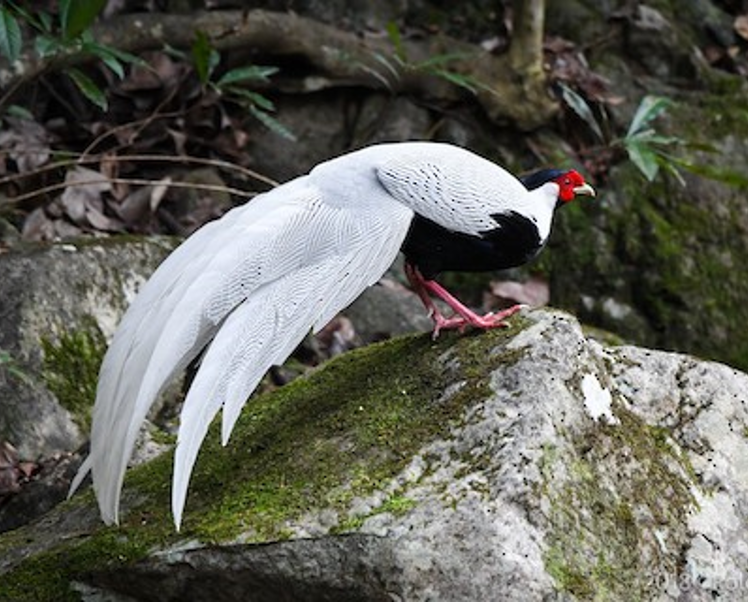Birdfinding.info ⇒ This spectacular fowl is rare across most of its range and generally shy, but locally common in few areas. It seems to be most readily observed in southeastern China: e.g., at Gutianshan in Zhejiang; Fuzhou National Forest Park and Emei Feng in Fujian; in and around Nanling National Forest Park in Guangdong; and in Jianfengling Forest Park on Hainan. Outside of China, most of the known reliable sites are in Thailand: near Bangkok at Khao Yai National Park, in the northeast at Nam Nao National Park and Phu Luang Wildlife Sanctuary; and in the northwest at Doi Angkhang Nature Resort and Chiang Dao Wildlife Sanctuary. A consistent site in central Vietnam is Bach Ma National Park.
Silver Pheasant
Lophura nycthemera
Tropical and subtropical forests of Southeast Asia, from foothills to mountains.
The Silver Pheasant is taxonomically complex, consisting of many races (fifteen recognized subspecies) that differ widely in appearance. Adding to the complexity, its sibling species, the Kalij Pheasant, shows a similar degree of variation, or more, and the races of Kalij and Silver that occupy adjacent areas sometimes interbreed and resemble one another more than either of them resembles distant races of their own species. The current classification of these intermediate races, along with the division of all Kalij-Silver races into two species, is based on genetic analyses of relatedness that strongly indicate both the validity of the distinction and the location of the line between them.
The bulk of its range consists of mountainous forested areas of southern China (from northwestern Yunnan east through Zhejiang), northern and eastern Myanmar, northern Thailand, Laos, and northern and central Vietnam.
Disjunct populations occur in few areas: (1) west-central Sichaun; (2) southwestern Guizhou; (3) Hainan Island; (5) southeastern Thailand and southwestern Cambodia; and (6) southern Vietnam into southeastern Cambodia.
Identification
A highly variable, sexually dimorphic pheasant with bright-red facial skin, coral-red or pink legs, and long, broad tail feathers. Male is large (up 125 cm long, including 75 cm tail in the largest subspecies) and robust (up to 1 kg). Female is about three-quarters of the length and half the bulk of smaller males.
Males have jet-black underparts, white upperparts that are variably textured with thin gray or black markings, and a black topknot that usually lays flat. The subspecies vary widely in the length of the tail (25-75 cm) and in the extent and pattern of the black markings on their upperparts.

Silver Pheasant. L. n. fokiensis, male. (Ruyang, Guangdong, China; September 23, 2018.) © Vincent Wang
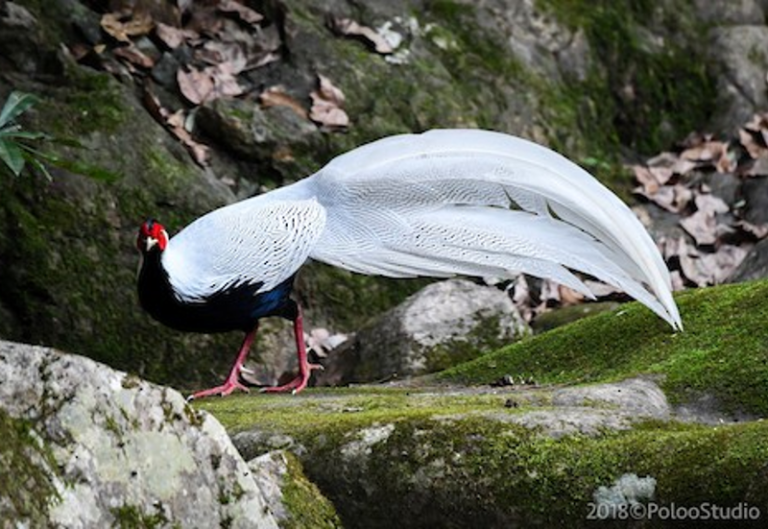
Silver Pheasant. L. n. fokiensis, male with luxuriant tail feathers. (Gutianshan, Zhejiang, China; February 23, 2018.) © Will Yan
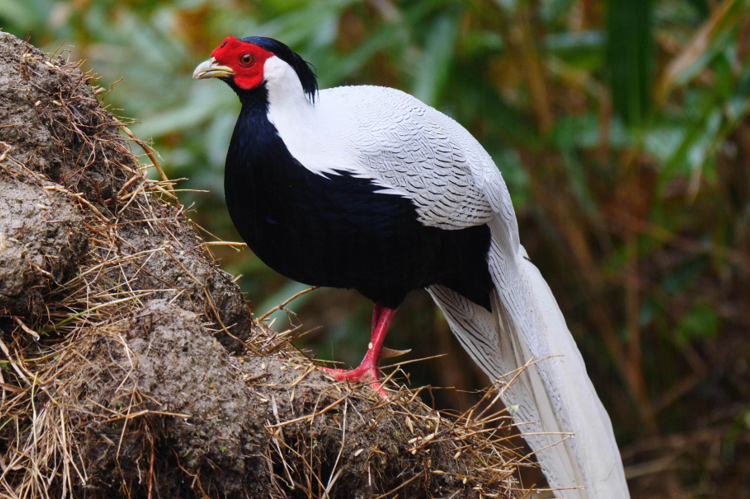
Silver Pheasant. L. n. fokiensis, male. (Ziyuncun, Sanming Shi, Fujian, China; January 28, 2018.) © Josep del Hoyo

Silver Pheasant. L. n. fokiensis, male. (Ruyang, Guangdong, China; September 23, 2018.) © Vincent Wang
In general, the northern races have the longest tails and nearly pure-white upperparts and tails, whereas the southern races have much shorter and proportionately broad tails, and tend to have darker and denser gray or black markings on the upperparts vary from a few sparse bars on the wings and outer tail feathers to dense vermiculations throughout—such that it appears gray at a distance.
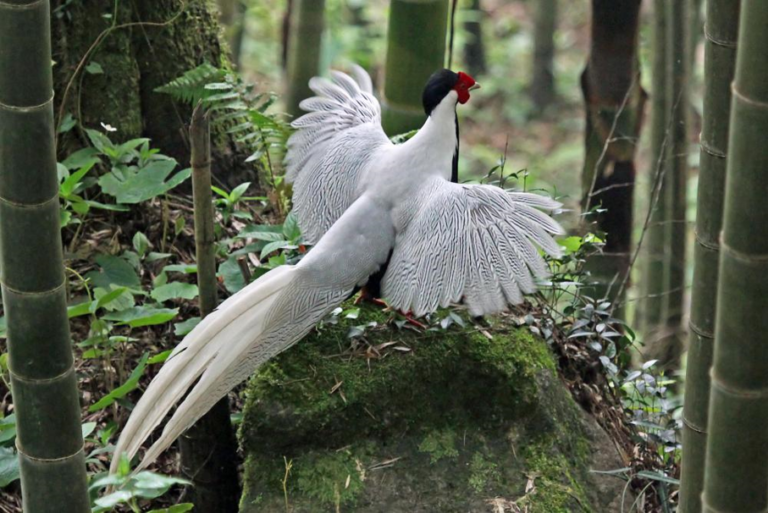
Silver Pheasant. L. n. fokiensis, male. (Emei Feng, Taining County, Fujian, China; April 26, 2015.) © Phillip Edwards
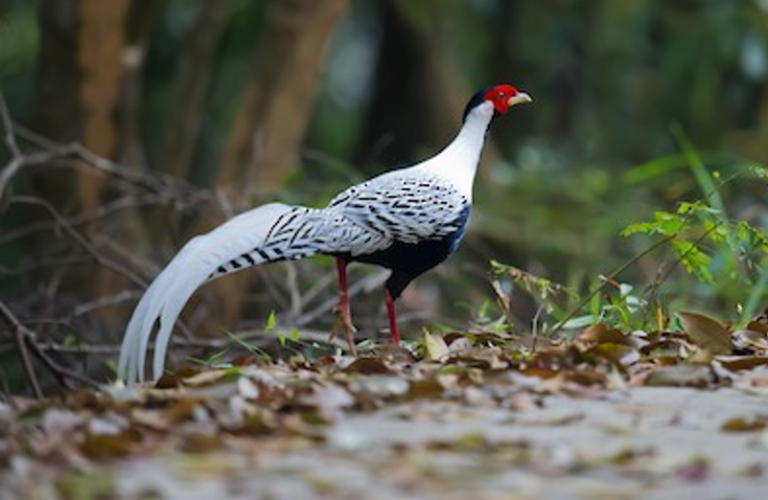
Silver Pheasant. L. n. whiteheadi, male. (Bawangling, Hainan, China; January 28, 2013.) © Craig Brelsford

Silver Pheasant. L. n. jonesi, male. (Wat Tham Chiang Do, Chiang Mai, Thailand; December 17, 2013.) © Rosemary Lloyd

Silver Pheasant. L. n. jonesi, male. (Khao Yai National Park, Thailand; March 26, 2019.) © Laurie Ross
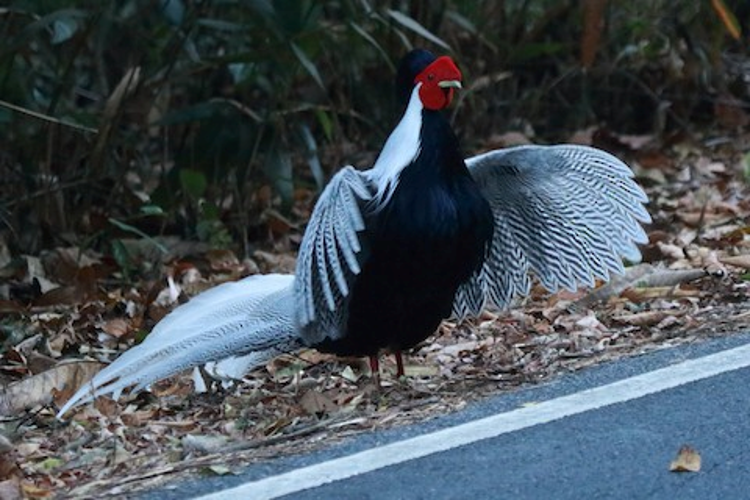
Silver Pheasant. L. n. jonesi, male. (Tambon Hin Tung, Chang Wat, Nakhon Nayok, Thailand; January 6, 2020.) © Fabio Olmos
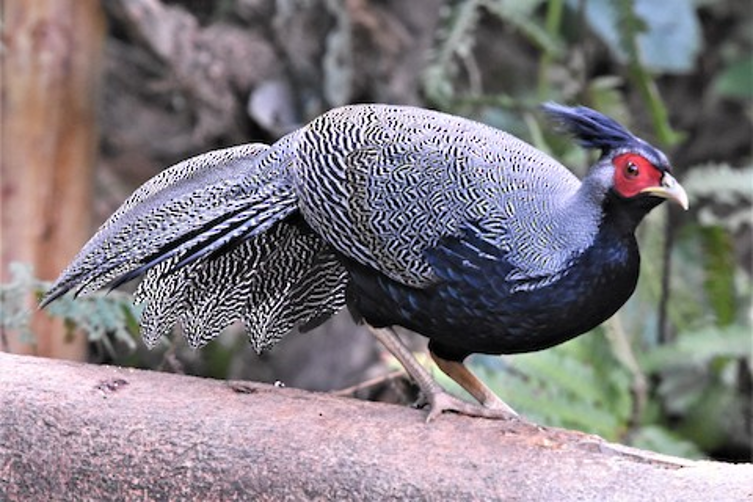
Silver Pheasant. L. n. jonesi, male. (Hongbenghe, Yunnan, China; January 4, 2019.) © Steve Bale
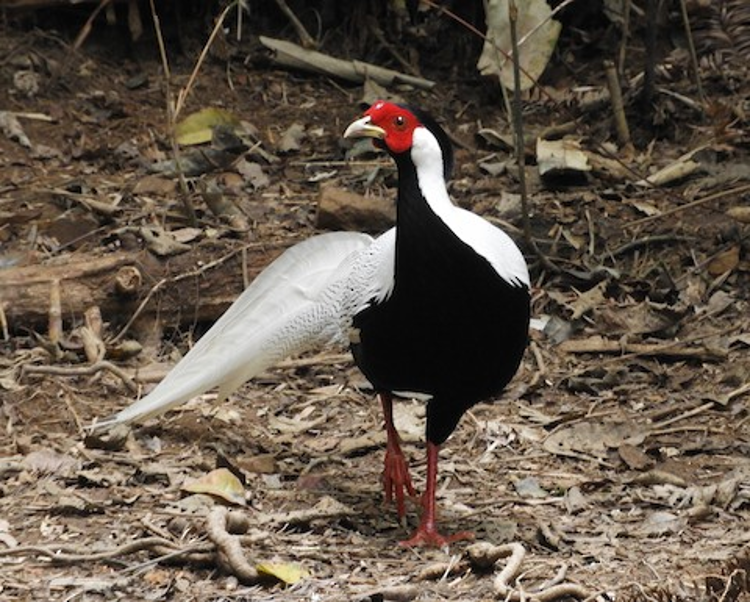
Silver Pheasant. L. n. fokiensis, male. (Zhangfang, Fujian, China; January 3, 2020.) © Frank Antram
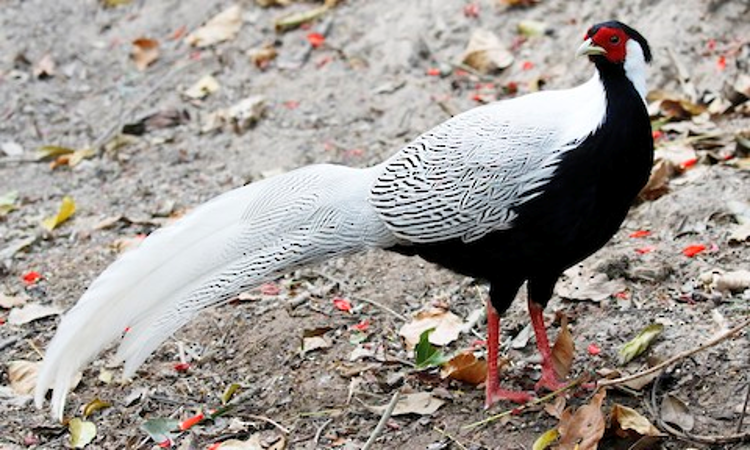
Silver Pheasant. L. n. jonesi, male. (Phu Khieo Wildlife Sanctuary, Chaiyaphum, Thailand; February 2, 2016.) © Paul Farrell

Silver Pheasant. L. n. jonesi, male. (Khao Yai National Park, Thailand; March 1, 2010.) © Rob Hutchinson

Silver Pheasant. L. n. beli, male. (Bach Ma National Park, Annam, Vietnam; March 10, 2018.) © Lars Petersson
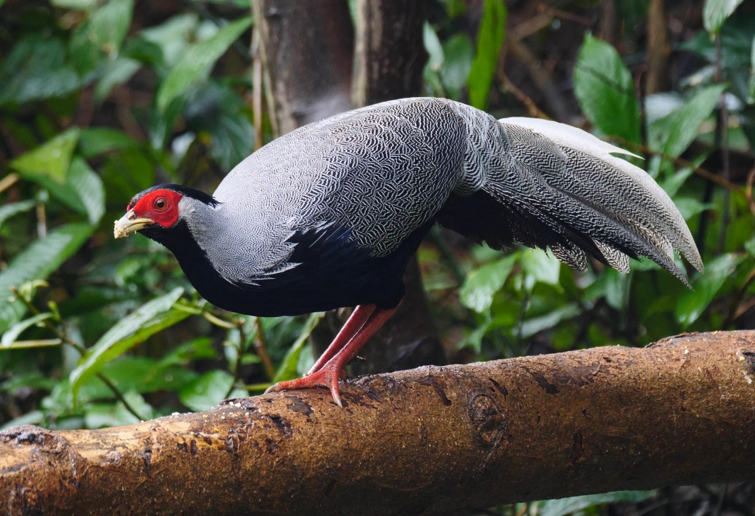
Silver Pheasant. L. n. jonesi, male. (Hornbill Valley, Yingjiang, Yunnan, China; January 9, 2019.) © Josep del Hoyo

Silver Pheasant. L. n. beli, male. (Bach Ma National Park, Annam, Vietnam; March 10, 2018.) © Lars Petersson
Females of most subspecies are typically medium- or dark-brown above, with tan or grayish scaling, and often paler gray around the face, neck, and throat.
Their underparts are typically darker brown, often infused with gray or black. Females of some subspecies are blackish-brown overall, with some pale-gray markings on the underparts.
The female’s tail is brown overall. Races differ in the color and pattern of the outer tail feathers: some are brown, some are blackish, and some have fine black-and-white barring.
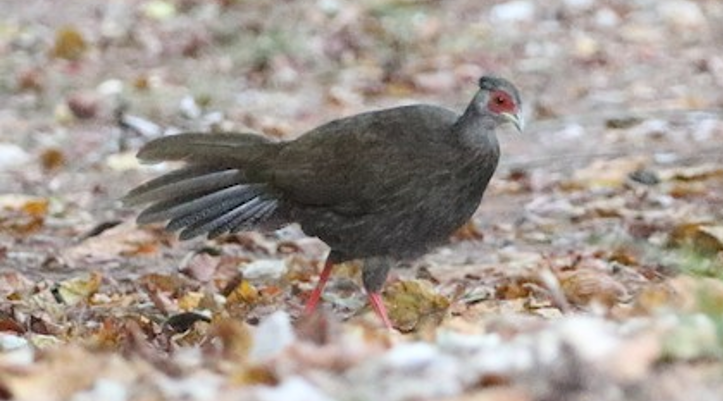
Silver Pheasant. L. n. fokiensis, female—note pale gray face and throat. (Emei Feng, Fujian, China; November 12, 2019.) © Richard Fuller

Silver Pheasant. L. n. jonesi, female—note black-and-white barred outer tail feathers. (Khao Yai National Park, Thailand; January 22, 2018.) © Brad Murphy

Silver Pheasant. L. n. fokiensis, female. (Ziyuncun, Sanming Shi, Fujian, China; January 28, 2018.) © Josep del Hoyo
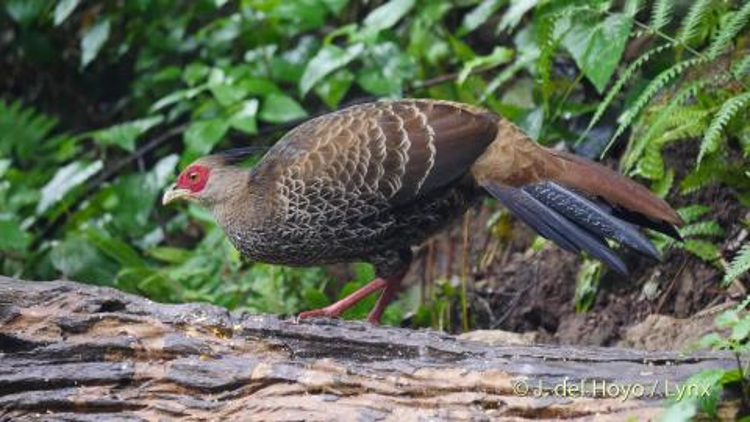
Silver Pheasant. L. n. jonesi, female showing grayish scaling—note mostly blackish outer tail feathers. (Hornbill Valley, Yingjiang, Yunnan, China; January 9, 2019.) © Josep del Hoyo
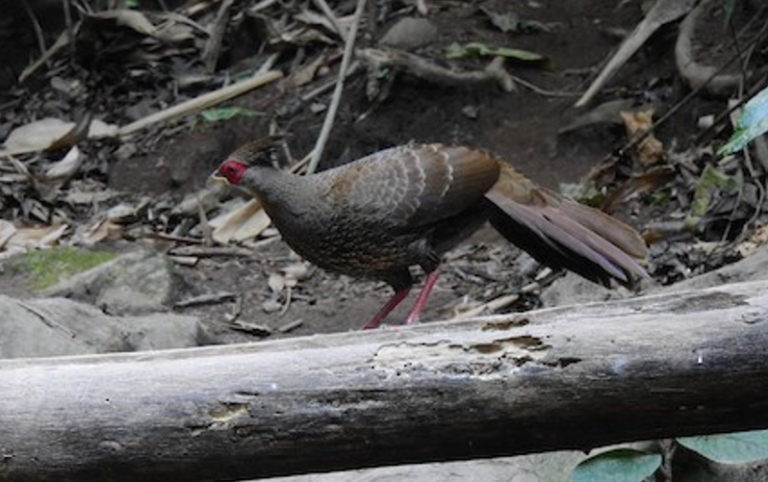
Silver Pheasant. L. n. jonesi, female showing grayish scaling. (Hongbenghe, Yunnan, China; February 2, 2018.) © Liao Tzu-Chiang
Immature males resemble females, but typically differ in having paler tails and darker underparts—more so as they mature into adult male plumage

Silver Pheasant. L. n. jonesi, females or immature males—probably the latter, judging by the apparently pale central tail feathers. (Khao Yai National Park, Thailand; January 13, 2016.) © Frédéric Pelsy
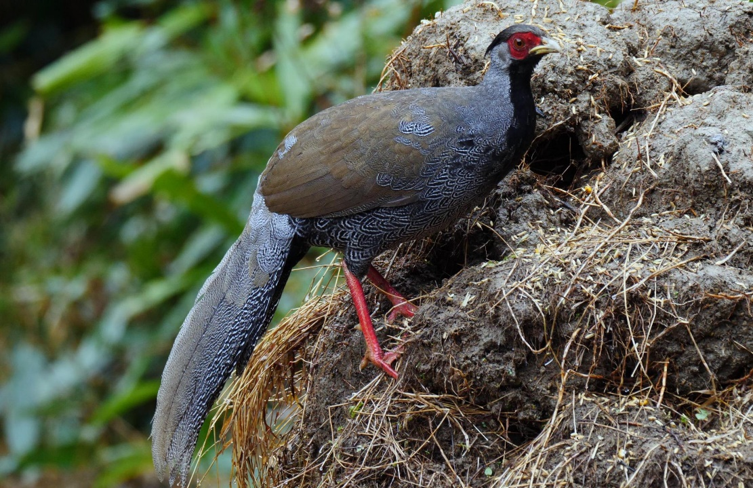
Silver Pheasant. L. n. fokiensis, immature male molting into adult plumage. (Ziyuncun, Sanming Shi, Fujian, China; January 28, 2018.) © Josep del Hoyo

Silver Pheasant. L. n. fokiensis, female. (Zhangfang, Fujian, China; January 3, 2020.) © Frank Antram

Silver Pheasant. L. n. fokiensis, likely an immature male based on black throat. (Emei Feng, Fujian, China; January 17, 2020.) © Lefei Han
Cf. Kalij Pheasant. Kalij and Silver Pheasants together comprise 24 recognized subspecies, each of which occupies a patch of southern Asia between northern Pakistan and eastern China, and south through most of Indochina to southwestern Thailand and southern Vietnam. The races of each species vary widely in appearance, and some are confusingly similar or resemble races of the other species. Based on genetic evidence, some subspecies that were traditionally classified as Silver have been reclassified as Kalij.

Silver Pheasant. L. n. jonesi, male. (Hornbill Valley, Yingjiang, Yunnan, China; January 9, 2019.) © Josep del Hoyo
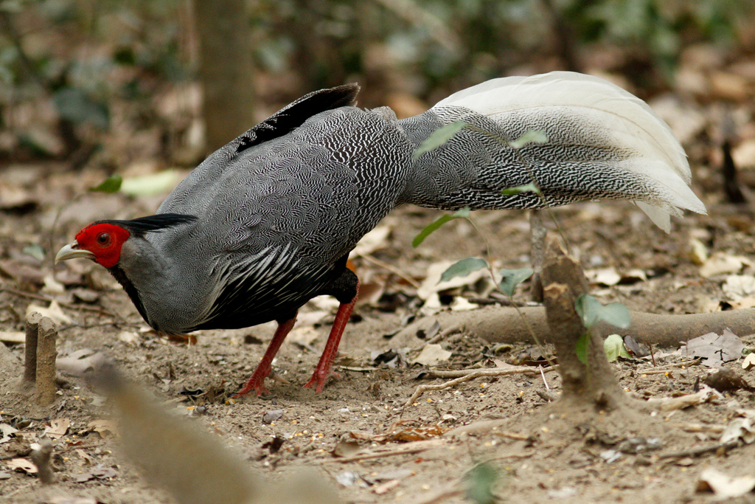
Kalij Pheasant. L. 1. crawfordi, male. (Kaeng Krachan National Park, Phetchaburi, Thailand; February 28, 2016.) © Julien Renoult
The zone of occasional or potential overlap between Kalij and Silver Pheasants (as currently understood) runs vertically on a map from western Yunnan Province in southern China south through eastern Myanmar, through northern and central Thailand. The populations west of this area are classified as Kalij and those to the east as Silver. In most areas, location is sufficient for identification—in some cases, location is more reliable than appearance due to the internal variability of each species and their overall similarity to one another.
Confusion is most likely in the mountain forests from Yunnan to Chiang Mai (Thailand), where their normal ranges may be separated by only a few miles, and occasional intermingling occurs, though in most such areas observers will likely have the benefit of local knowledge to understand which race is expected there and which others occur in nearby areas.
Males of the highly similar races have black underparts, white upperparts that are variably covered with fine black vermiculations, medium-to-short tails (by Silver Pheasant standards) that match the upperparts, and a black topknot. As a general rule of thumb, male Silver Pheasants show more contrast: they have whiter upperparts and the black vermiculations stand out as lines, whereas male Kalij Pheasants appear partly gray unless seen at very close range.
Females of both species vary less than males, but overlap more in appearance. Most female Silver Pheasants are plainer brown than their Kalij counterparts, and show far less prominent scaling or barring. However, the most heavily patterned female Silvers are essentially identical to the least heavily patterned Kalij Pheasants, and probably would not distinguishable unless accompanied by a male—but this would not necessarily be a reliable indicator, as they have been known to hybridize.
Notes
Polytypic species consisting of fifteen recognized subspecies, with strong geographical variation.
An additional three subspecies that occur southwest of its range (in eastern Myanmar and western Thailand) were traditionally classified under the Silver Pheasant, but have been reclassified as Kalij Pheasant based on genetic evidence.
References
BirdLife International. 2016. Lophura nycthemera. The IUCN Red List of Threatened Species 2016: e.T22679220A92808107. https://dx.doi.org/10.2305/IUCN.UK.2016-3.RLTS.T22679220A92808107.en. (Accessed February 13, 2020.)
eBird. 2020. eBird: An online database of bird distribution and abundance. Cornell Lab of Ornithology, Ithaca, N.Y. http://www.ebird.org. (Accessed February 13 2020.)
McGowan, P.J.K., and G.M. Kirwan. 2020. Silver Pheasant (Lophura nycthemera). In Handbook of the Birds of the World Alive (J. del Hoyo, A. Elliott, J. Sargatal, D.A. Christie, and E. de Juana, eds.). Lynx Edicions, Barcelona. https://www.hbw.com/node/53490. (Accessed February 13, 2020.)
Moulin, S., E. Randi, C. Tabarroni, and A. Hennache. 2003. Mitochondrial DNA diversification among the subspecies of the Silver and Kalij Pheasants, Lophura nycthemera and L. leucomelanos, Phasianidae. Ibis 145:E1-E11.
Robson, C. 2002. Birds of Thailand. Princeton University Press, Princeton, N.J.
